technical data SKODA OCTAVIA 2007 1.G / (1U) Repair Manual
[x] Cancel search | Manufacturer: SKODA, Model Year: 2007, Model line: OCTAVIA, Model: SKODA OCTAVIA 2007 1.G / (1U)Pages: 288, PDF Size: 15.19 MB
Page 128 of 288
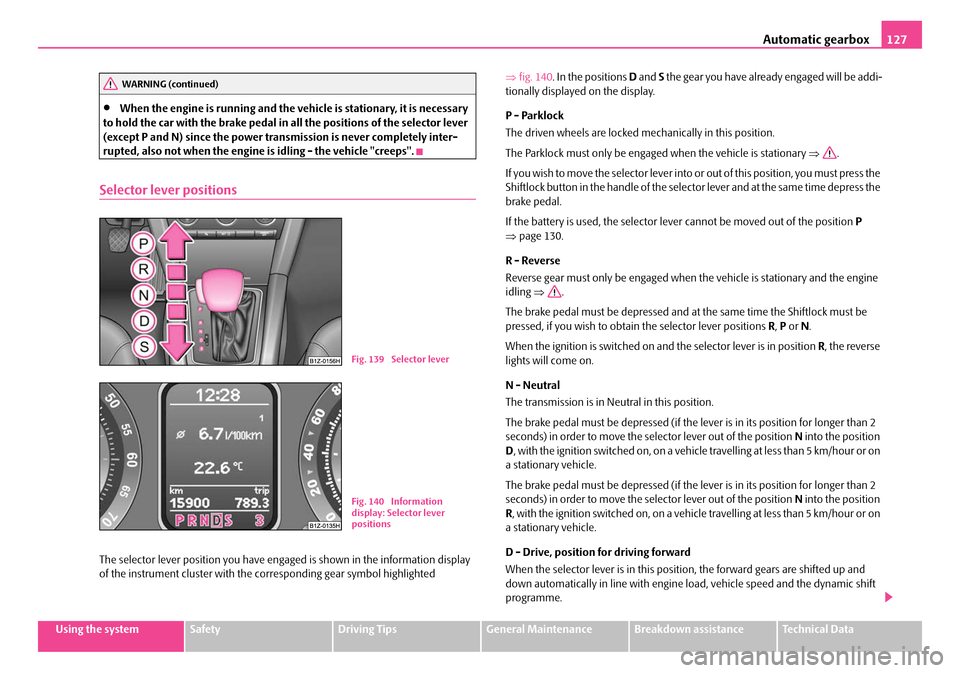
Automatic gearbox127
Using the systemSafetyDriving TipsGeneral MaintenanceBreakdown assistanceTechnical Data
•When the engine is running and the vehicle is stationary, it is necessary
to hold the car with the brake pedal in all the positions of the selector lever
(except P and N) since the power transmission is never completely inter-
rupted, also not when the engine is idling - the vehicle "creeps".
Selector lever positions
The selector lever position you have engaged is shown in the information display
of the instrument cluster with the co rresponding gear symbol highlighted ⇒
fig. 140 . In the positions D and S the gear you have already engaged will be addi-
tionally displayed on the display.
P - Parklock
The driven wheels are locked me chanically in this position.
The Parklock must only be engage d when the vehicle is stationary ⇒.
If you wish to move the select or lever into or out of this position, you must press the
Shiftlock button in the handle of the select or lever and at the same time depress the
brake pedal.
If the battery is used, the selector le ver cannot be moved out of the position P
⇒ page 130.
R - Reverse
Reverse gear must only be engaged when the vehicle is stationary and the engine
idling ⇒ .
The brake pedal must be depressed and at the same time the Shiftlock must be
pressed, if you wish to obtain the selector lever positions R, P or N.
When the ignition is switched on and the selector lever is in position R, the reverse
lights will come on.
N - Neutral
The transmission is in Neutral in this position.
The brake pedal must be depressed (if the le ver is in its position for longer than 2
seconds) in order to move the selector lever out of the position N into the position
D , with the ignition switched on, on a vehicle travelling at less than 5 km/hour or on
a stationary vehicle.
The brake pedal must be depressed (if the le ver is in its position for longer than 2
seconds) in order to move the selector lever out of the position N into the position
R , with the ignition switched on, on a vehicl e travelling at less than 5 km/hour or on
a stationary vehicle.
D - Drive, position for driving forward
When the selector lever is in this position, the forward gears are shifted up and
down automatically in line with engine load, vehicle speed and the dynamic shift
programme.
WARNING (continued)
Fig. 139 Selector lever
Fig. 140 Information
display: Selector lever
positions
NKO A5 20 MR08.book Page 127 Wednesday, April 11, 2007 2:54 PM
Page 130 of 288
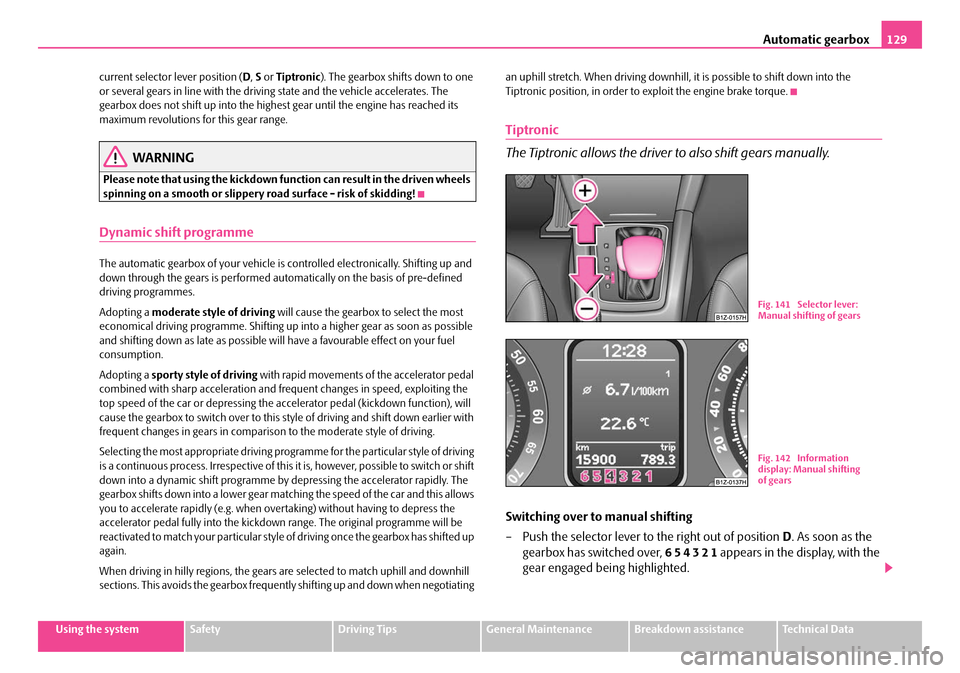
Automatic gearbox129
Using the systemSafetyDriving TipsGeneral MaintenanceBreakdown assistanceTechnical Data
current selector lever position (
D, S or Tiptronic ). The gearbox shifts down to one
or several gears in line with the driving state and the vehicle accelerates. The
gearbox does not shift up into the highes t gear until the engine has reached its
maximum revolutions for this gear range.
WARNING
Please note that using the kickdown fu nction can result in the driven wheels
spinning on a smooth or slippery road surface - risk of skidding!
Dynamic shift programme
The automatic gearbox of your vehicle is controlled electronically. Shifting up and
down through the gears is performed auto matically on the basis of pre-defined
driving programmes.
Adopting a moderate style of driving will cause the gearbox to select the most
economical driving programme. Shifting up into a higher gear as soon as possible
and shifting down as late as possible will have a favourable effect on your fuel
consumption.
Adopting a sporty style of driving with rapid movements of the accelerator pedal
combined with sharp acceleration and freq uent changes in speed, exploiting the
top speed of the car or depressing the a ccelerator pedal (kickdown function), will
cause the gearbox to switch over to this style of driving and shift down earlier with
frequent changes in gears in comparison to the moderate style of driving.
Selecting the most appropriate driving programme for the particular style of driving
is a continuous process. Irrespective of this it is, however, possible to switch or shift
down into a dynamic shift programme by depressing the accelerator rapidly. The
gearbox shifts down into a lower gear matc hing the speed of the car and this allows
you to accelerate rapidly (e.g. when ov ertaking) without having to depress the
accelerator pedal fully into the kickdown range. The original programme will be
reactivated to match your particular style of driving once the gearbox has shifted up
again.
When driving in hilly regions, the gears are selected to match uphill and downhill
sections. This avoids the gearbox frequently shifting up and down when negotiating an uphill stretch. When driving downhill, it is possible to shift down into the
Tiptronic position, in order to
exploit the engine brake torque.
Tiptronic
The Tiptronic allows the driver to also shift gears manually.
Switching over to manual shifting
– Push the selector lever to the right out of position D. As soon as the
gearbox has switched over, 6 5 4 3 2 1 appears in the display, with the
gear engaged being highlighted.
Fig. 141 Selector lever:
Manual shifting of gears
Fig. 142 Information
display: Manual shifting
of gears
NKO A5 20 MR08.book Page 129 Wednesday, April 11, 2007 2:54 PM
Page 132 of 288
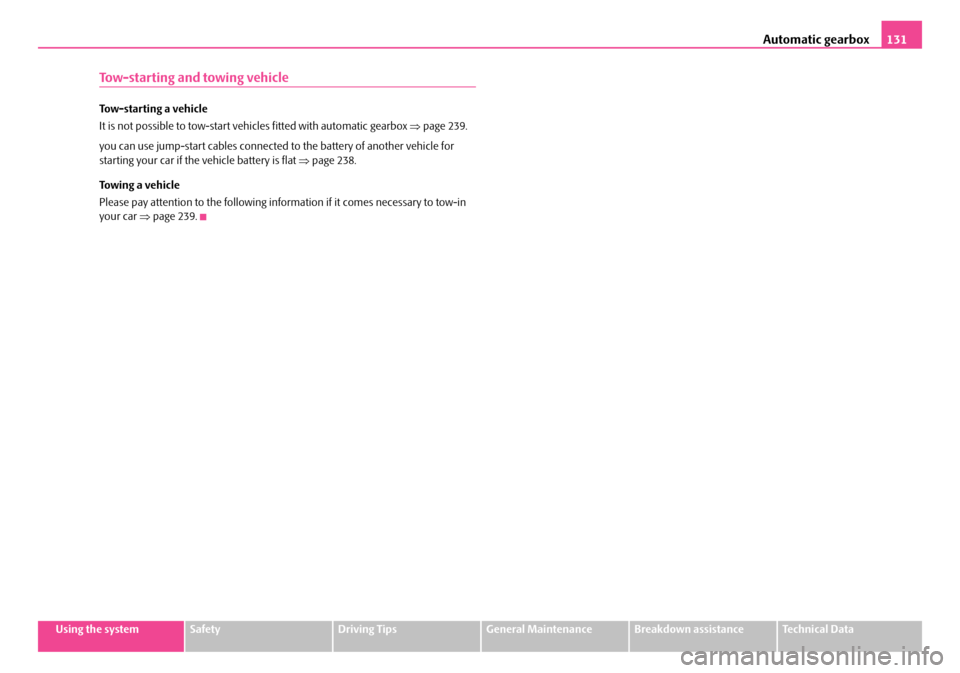
Automatic gearbox131
Using the systemSafetyDriving TipsGeneral MaintenanceBreakdown assistanceTechnical Data
Tow-starting and towing vehicle
Tow-starting a vehicle
It is not possible to tow-start ve hicles fitted with automatic gearbox ⇒page 239.
you can use jump-start cables connected to the battery of another vehicle for
starting your car if the vehicle battery is flat ⇒page 238.
Towing a vehicle
Please pay attention to the following information if it comes necessary to tow-in
your car ⇒page 239.
NKO A5 20 MR08.book Page 131 Wednesday, April 11, 2007 2:54 PM
Page 134 of 288
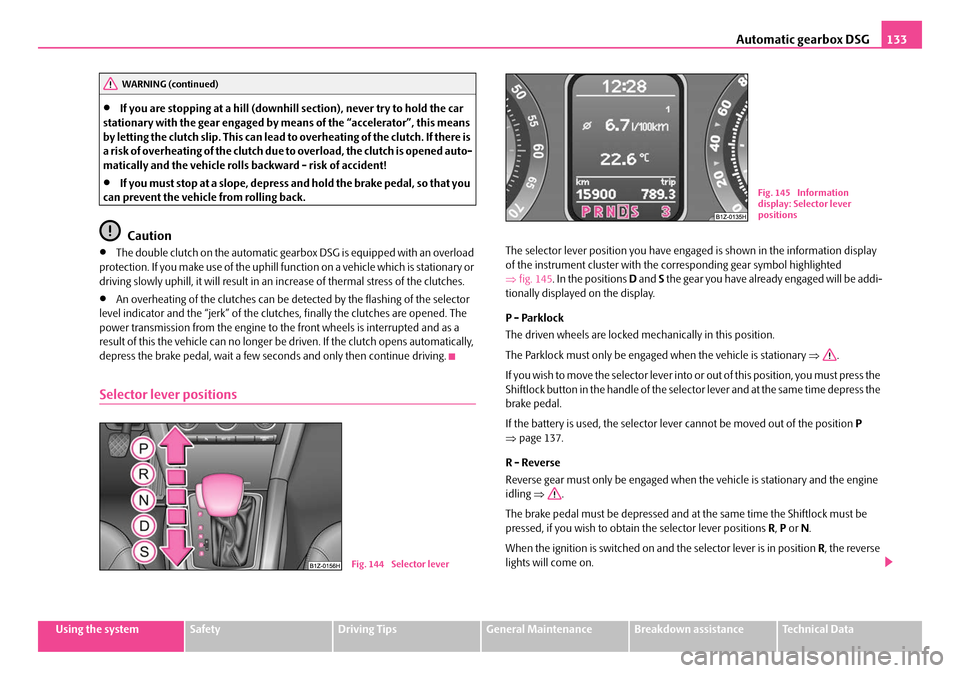
Automatic gearbox DSG133
Using the systemSafetyDriving TipsGeneral MaintenanceBreakdown assistanceTechnical Data
•If you are stopping at a hill (downhill section), never try to hold the car
stationary with the gear engaged by me ans of the “accelerator”, this means
by letting the clutch slip. This can lead to overheating of the clutch. If there is
a risk of overheating of the clutch due to overload, the clutch is opened auto-
matically and the vehicle rolls backward - risk of accident!
•If you must stop at a slope, depress and hold the brake pedal, so that you
can prevent the vehicle from rolling back.
Caution
•The double clutch on the automatic gear box DSG is equipped with an overload
protection. If you make use of the uphill f unction on a vehicle which is stationary or
driving slowly uphill, it will result in an increase of thermal stress of the clutches.
•An overheating of the clutches can be detected by the flashing of the selector
level indicator and the “jerk” of the clut ches, finally the clutches are opened. The
power transmission from the engine to the front wheels is interrupted and as a
result of this the vehicle ca n no longer be driven. If the clutch opens automatically,
depress the brake pedal, wait a few seconds and only then continue driving.
Selector lever positions
The selector lever position you have engaged is shown in the information display
of the instrument cluster with the co rresponding gear symbol highlighted
⇒ fig. 145 . In the positions D and S the gear you have already engaged will be addi-
tionally displayed on the display.
P - Parklock
The driven wheels are locked me chanically in this position.
The Parklock must only be engage d when the vehicle is stationary ⇒.
If you wish to move the select or lever into or out of this position, you must press the
Shiftlock button in the handle of the select or lever and at the same time depress the
brake pedal.
If the battery is used, the selector le ver cannot be moved out of the position P
⇒ page 137.
R - Reverse
Reverse gear must only be engaged when the vehicle is stationary and the engine
idling ⇒ .
The brake pedal must be depressed and at the same time the Shiftlock must be
pressed, if you wish to obtain the selector lever positions R, P or N.
When the ignition is switched on and the selector lever is in position R, the reverse
lights will come on.
WARNING (continued)
Fig. 144 Selector lever
Fig. 145 Information
display: Selector lever
positions
NKO A5 20 MR08.book Page 133 Wednesday, April 11, 2007 2:54 PM
Page 136 of 288
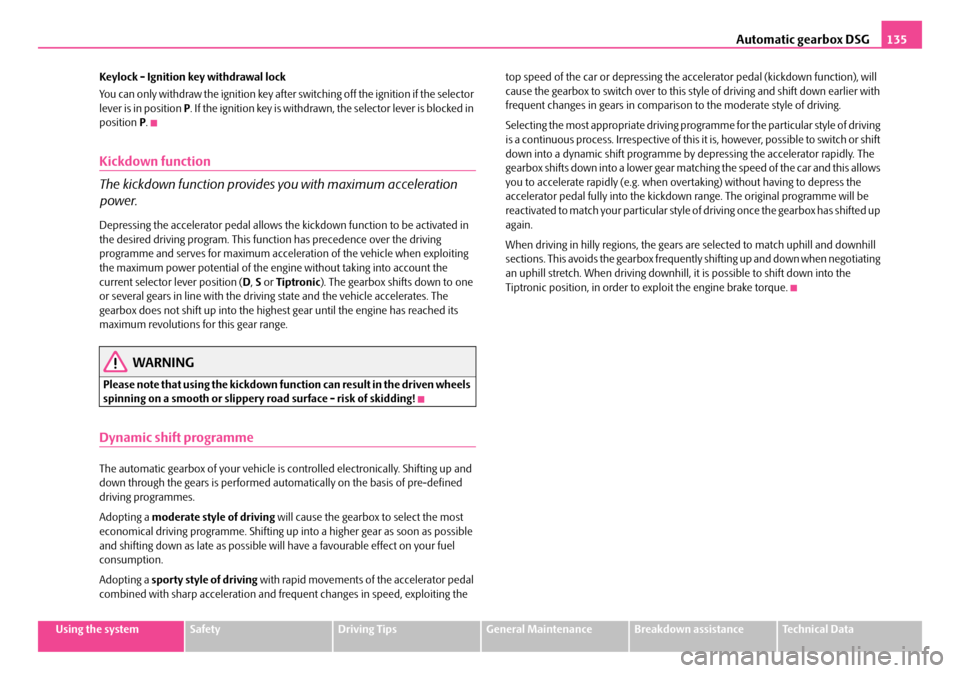
Automatic gearbox DSG135
Using the systemSafetyDriving TipsGeneral MaintenanceBreakdown assistanceTechnical Data
Keylock - Ignition key withdrawal lock
You can only withdraw the ignition key after
switching off the ignition if the selector
lever is in position P. If the ignition key is withdrawn, the selector lever is blocked in
position P.
Kickdown function
The kickdown function provides you with maximum acceleration
power.
Depressing the accelerator pe dal allows the kickdown function to be activated in
the desired driving program. This function has precedence over the driving
programme and serves for maximum accelera tion of the vehicle when exploiting
the maximum power potential of the engine without taking into account the
current selector lever position ( D, S or Tiptronic ). The gearbox shifts down to one
or several gears in line with the driving state and the vehicle accelerates. The
gearbox does not shift up into the highes t gear until the engine has reached its
maximum revolutions for this gear range.
WARNING
Please note that using the kickdown fu nction can result in the driven wheels
spinning on a smooth or slippery road surface - risk of skidding!
Dynamic shift programme
The automatic gearbox of your vehicle is controlled electronically. Shifting up and
down through the gears is performed auto matically on the basis of pre-defined
driving programmes.
Adopting a moderate style of driving will cause the gearbox to select the most
economical driving programme. Shifting up into a higher gear as soon as possible
and shifting down as late as possible will have a favourable effect on your fuel
consumption.
Adopting a sporty style of driving with rapid movements of the accelerator pedal
combined with sharp acceleration and freq uent changes in speed, exploiting the top speed of the car or depressing the a
ccelerator pedal (kickdown function), will
cause the gearbox to switch over to this st yle of driving and shift down earlier with
frequent changes in gears in comparison to the moderate style of driving.
Selecting the most appropriate driving programme for the particular style of driving
is a continuous process. Irrespective of this it is, however, possible to switch or shift
down into a dynamic shift programme by depressing the accelerator rapidly. The
gearbox shifts down into a lower gear matc hing the speed of the car and this allows
you to accelerate rapidly (e.g. when ov ertaking) without having to depress the
accelerator pedal fully into the kickdown range. The original programme will be
reactivated to match your particular style of driving once the gearbox has shifted up
again.
When driving in hilly regions, the gears are selected to match uphill and downhill
sections. This avoids the gearbox frequently shifting up and down when negotiating
an uphill stretch. When driving downhill, it is possible to shift down into the
Tiptronic position, in order to exploit the engine brake torque.
NKO A5 20 MR08.book Page 135 Wednesday, April 11, 2007 2:54 PM
Page 138 of 288
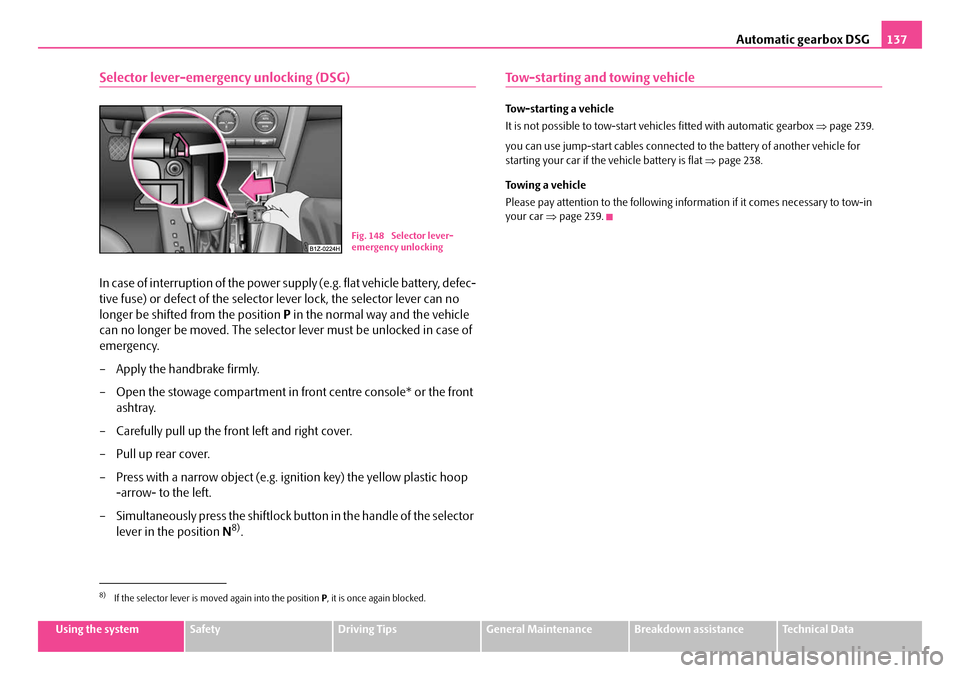
Automatic gearbox DSG137
Using the systemSafetyDriving TipsGeneral MaintenanceBreakdown assistanceTechnical Data
Selector lever-emergency unlocking (DSG)
In case of interruption of the power supply (e.g. flat vehicle battery, defec-
tive fuse) or defect of the selector lever lock, the selector lever can no
longer be shifted from the position P in the normal way and the vehicle
can no longer be moved. The selector lever must be unlocked in case of
emergency.
– Apply the handbrake firmly.
– Open the stowage compartment in front centre console* or the front ashtray.
– Carefully pull up the front left and right cover.
– Pull up rear cover.
– Press with a narrow object (e.g. ignition key) the yellow plastic hoop -arrow- to the left.
– Simultaneously press the shiftlock butt on in the handle of the selector
lever in the position N
8).
Tow-starting and towing vehicle
Tow-starting a vehicle
It is not possible to tow-start vehi cles fitted with automatic gearbox ⇒page 239.
you can use jump-start cables connected to the battery of another vehicle for
starting your car if the vehicle battery is flat ⇒page 238.
Towing a vehicle
Please pay attention to the following information if it comes necessary to tow-in
your car ⇒page 239.
8)If the selector lever is moved again into the position P, it is once again blocked.
Fig. 148 Selector lever-
emergency unlocking
NKO A5 20 MR08.book Page 137 Wednesday, April 11, 2007 2:54 PM
Page 140 of 288
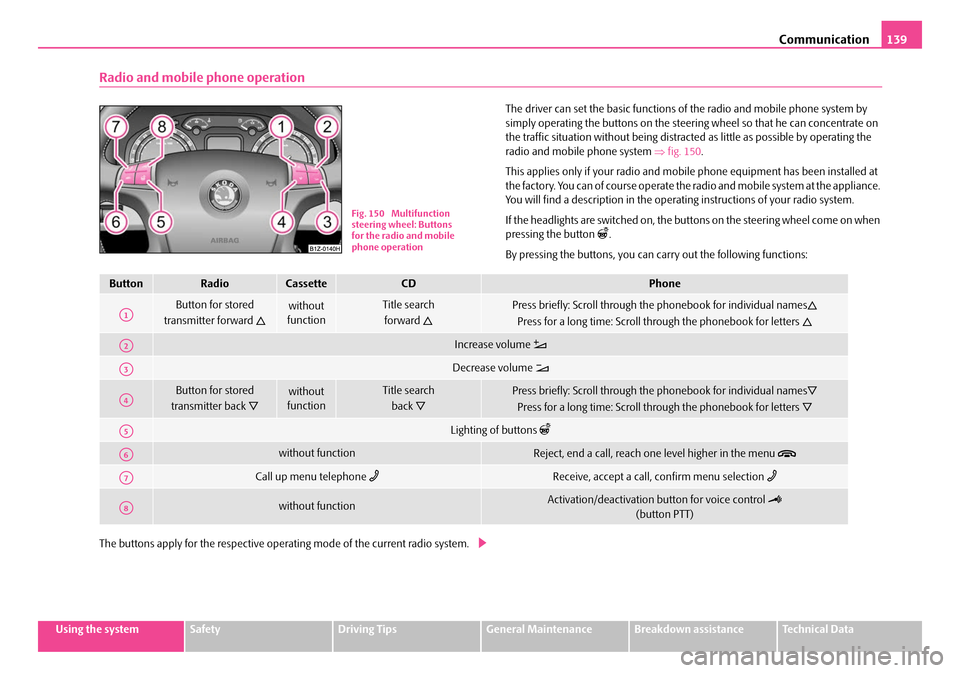
Communication139
Using the systemSafetyDriving TipsGeneral MaintenanceBreakdown assistanceTechnical Data
Radio and mobile phone operation
The driver can set the basic functions of the radio and mobile phone system by
simply operating the buttons on the steering wheel so that he can concentrate on
the traffic situation without being distracted as little as possible by operating the
radio and mobile phone system ⇒fig. 150 .
This applies only if your radio and mobi le phone equipment has been installed at
the factory. You can of course operate the radio and mobile system at the appliance.
You will find a description in the operating instructions of your radio system.
If the headlights are switched on, the buttons on the steering wheel come on when
pressing the button
.
By pressing the buttons, you can carry out the following functions:
The buttons apply for the respective operating mode of the current radio system.
Fig. 150 Multifunction
steering wheel: Buttons
for the radio and mobile
phone operation
ButtonRadioCassetteCDPhone
Button for stored
transmitter forward
without
functionTitle search
forward
Press briefly: Scroll through the phonebook for individual names
Press for a long time: Scroll through the phonebook for letters
Increase volume
Decrease volume
Button for stored
transmitter back
without
functionTitle search
back
Press briefly: Scroll through the phonebook for individual names
Press for a long time: Scroll through the phonebook for letters
Lighting of buttons
without functionReject, end a call, reach one level higher in the menu
Call up menu telephone Receive, accept a call, confirm menu selection
without functionActivation/deactivation button for voice control
(button PTT)
A1
A2
A3
A4
A5
A6
A7
A8
NKO A5 20 MR08.book Page 139 Wednesday, April 11, 2007 2:54 PM
Page 142 of 288
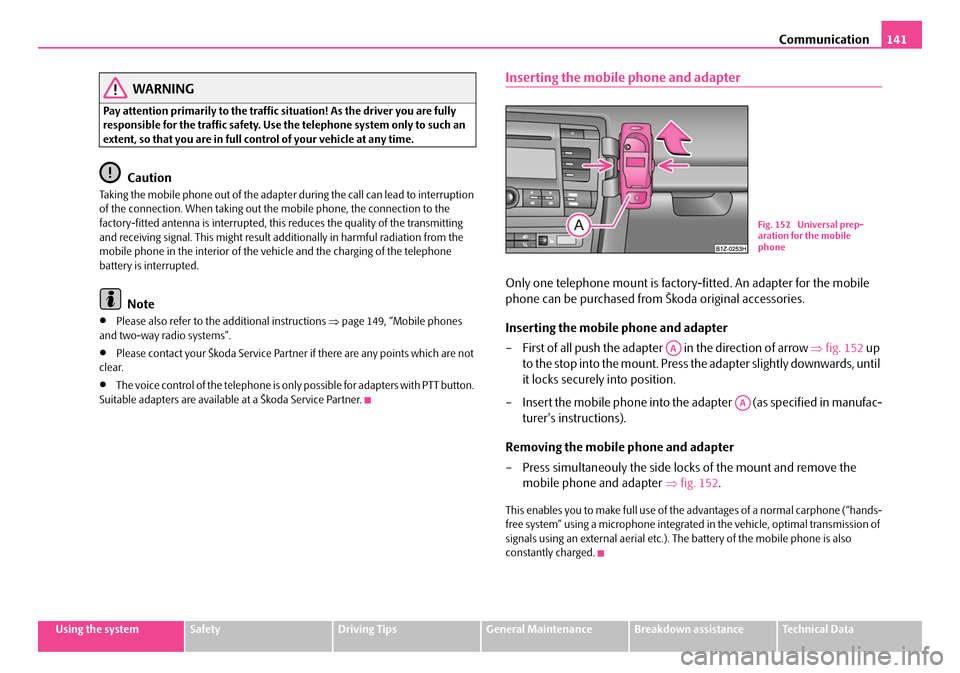
Communication141
Using the systemSafetyDriving TipsGeneral MaintenanceBreakdown assistanceTechnical Data
WARNING
Pay attention primarily to the traffic situation! As the driver you are fully
responsible for the traffic safety. Use the telephone system only to such an
extent, so that you are in full control of your vehicle at any time.
Caution
Taking the mobile phone out of the adapter during the call can lead to interruption
of the connection. When taking out the mobile phone, the connection to the
factory-fitted antenna is interrupted, this reduces the quality of the transmitting
and receiving signal. This might result additionally in harmful radiation from the
mobile phone in the interior of the ve hicle and the charging of the telephone
battery is interrupted.
Note
•Please also refer to the additional instructions ⇒page 149, “Mobile phones
and two-way radio systems”.
•Please contact your Škoda Service Partner if there are any points which are not
clear.
•The voice control of the telephone is only possible for adapters with PTT button.
Suitable adapters are available at a Škoda Service Partner.
Inserting the mobile phone and adapter
Only one telephone mount is factory-fitted. An adapter for the mobile
phone can be purchased from Škoda original accessories.
Inserting the mobile phone and adapter
– First of all push the adapter in the direction of arrow ⇒fig. 152 up
to the stop into the mount. Press the adapter slightly downwards, until
it locks securely into position.
– Insert the mobile phone into the adapter (as specified in manufac- turer's instructions).
Removing the mobile phone and adapter
– Press simultaneouly the side locks of the mount and remove the mobile phone and adapter ⇒fig. 152 .
This enables you to make full use of the advantages of a normal carphone (“hands-
free system” using a microphone integrated in the vehicle, optimal transmission of
signals using an external aerial etc.). The battery of the mobile phone is also
constantly charged.
Fig. 152 Universal prep-
aration for the mobile
phone
AA
AA
NKO A5 20 MR08.book Page 141 Wednesday, April 11, 2007 2:54 PM
Page 144 of 288

Communication143
Using the systemSafetyDriving TipsGeneral MaintenanceBreakdown assistanceTechnical Data
You can operate the mobile phone via the voice control
⇒page 140 or via the
buttons of the multifunction steering wheel ⇒page 139.
Voice commands
Voice commands for mobile phone operation Voice commands for operating the phone phone book
Other possible commands
Number
engagedLine Busy
No service foundNo Service
Enter PIN codeEnter PIN
Voice commandActivity
ENTER PIN/PIN CODEAfter this command the PIN code of the mobile
phone can be entered ⇒page 144.
DIAL NUMBERAfter this command a telephone number can be
entered which establishes a connection to the
requested partner ⇒page 144.
REDIALAfter this command the last selected telephone
number is selected again ⇒page 145.
ActivityRead out in display
Voice commandActivity
SAVE/STORE
NAMES/NAME/NUMB ERAfter this command a name with its telephone
number can be stored in the phone phone book
⇒page 145.
SELECT NAMES/NAMEAfter this command a telephone number which
was stored under its given name in the phone
phone book can be selected ⇒ page 146.
DELETE NAMES/NAMEAfter this command a name in the phone phone
book can be erased ⇒page 146.
LISTEN TO/PLAY
PHONEBOOKAfter this command you ca n listen-in to the phone
phone book ⇒page 146.
DELETE PHONEBOOKAfter this command the complete phone book or a
name can be erased ⇒page 147.
Voice commandActivity
DIALThe telephone number is selected.
STOREThe name and the telephone number are stored in
the phone phonebook or the entered PIN code is
stored.
REPEATThe entered name or the digits are repeated. Then
the system requests with voice response “ please
proceed ” the entry of further digits or commands.
NKO A5 20 MR08.book Page 143 Wednesday, April 11, 2007 2:54 PM
Page 146 of 288

Communication145
Using the systemSafetyDriving TipsGeneral MaintenanceBreakdown assistanceTechnical Data
When entering more than 20 digits, the system answers with voice response “
The
number is too long ”.
Additionally for international calls a Plus (+) has to be entered in front of the 20
digits.
Example when entering a telephone number
You can interrupt the dialogue at any time by pressing the PTT button or with the
voice command CANCEL.
Repeat last call
– Press the PTT button.
– Give the command REDIAL after the signal tone.
After giving this command, the last number selected via voice input is selected
again.
Example of redial You can interrupt the dialogue at any time
by pressing the PTT button or with the
voice command CANCEL.
Phone voice phonebook*
Store name
– Press the PTT button.
– Give the command SAVE/STORE NAMES/NAME/NUMBER after the
signal tone.
After giving this command, the system re quests the entry of a name and a tele-
phone number which should be stored in the phone voice phonebook. In the
phone voice phonebook up to 50 entries can be stored.
The telephone number can be entered as an interconnected spoken row of digits
(complete number), in the form of order of digits (separation through a brief voice
pause) or through individually spoken digits. After each order of digits (separation
through brief voice pa use) the detected digits are repeated.
The digits zero to nine are permitted. The system detects no continuous digit
combinations such as twenty-three, but only individually spoken digits (two, three).
When entering more than 20 digits, th e system answers with voice response “The
number is too long ”.
Additionally a Plus (+) has to be entered in front of the 20 digits.
The stored entry is displayed on the information display* with an arrow in front of
the name.
For similar names additional information (e.g. first names) should be stored.
Voice commandAnnouncement
DIAL NUMBER“ The number please ”
e.g. ZERO SIX ZERO THREE“Zero Six Zero Three ”
If no entry is put in, the following announcement is made after about 5 sec-
onds.
“Possible commands are: dial, repeat,
back, delete or more digits ”
FIVE SEVEN TWO“Five Seven Two ”
DIAL“The number is being dialed ”
Voice commandAnnouncement
REDIAL“The number is being dialed ”
NKO A5 20 MR08.book Page 145 Wednesday, April 11, 2007 2:54 PM